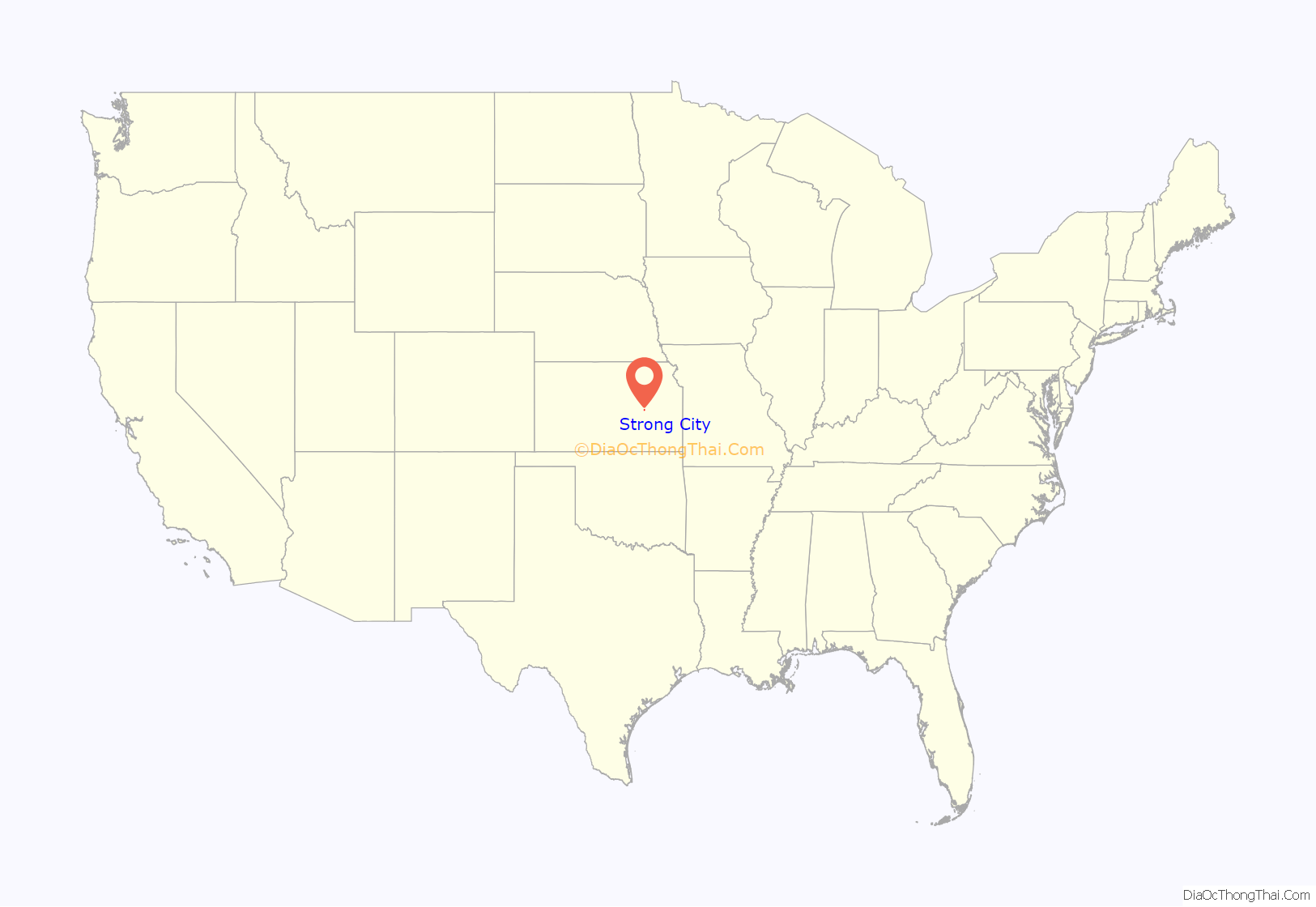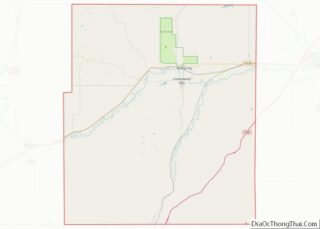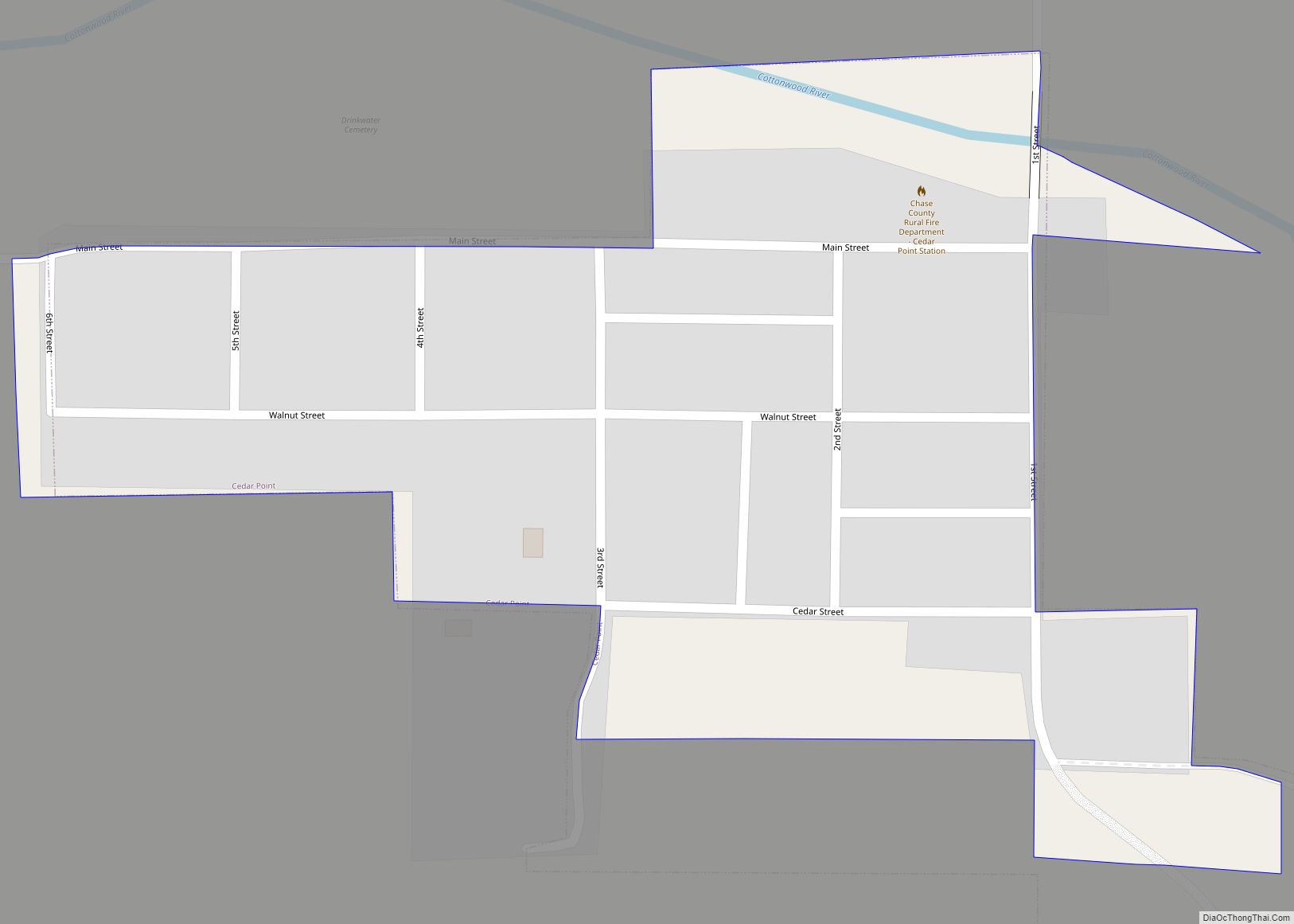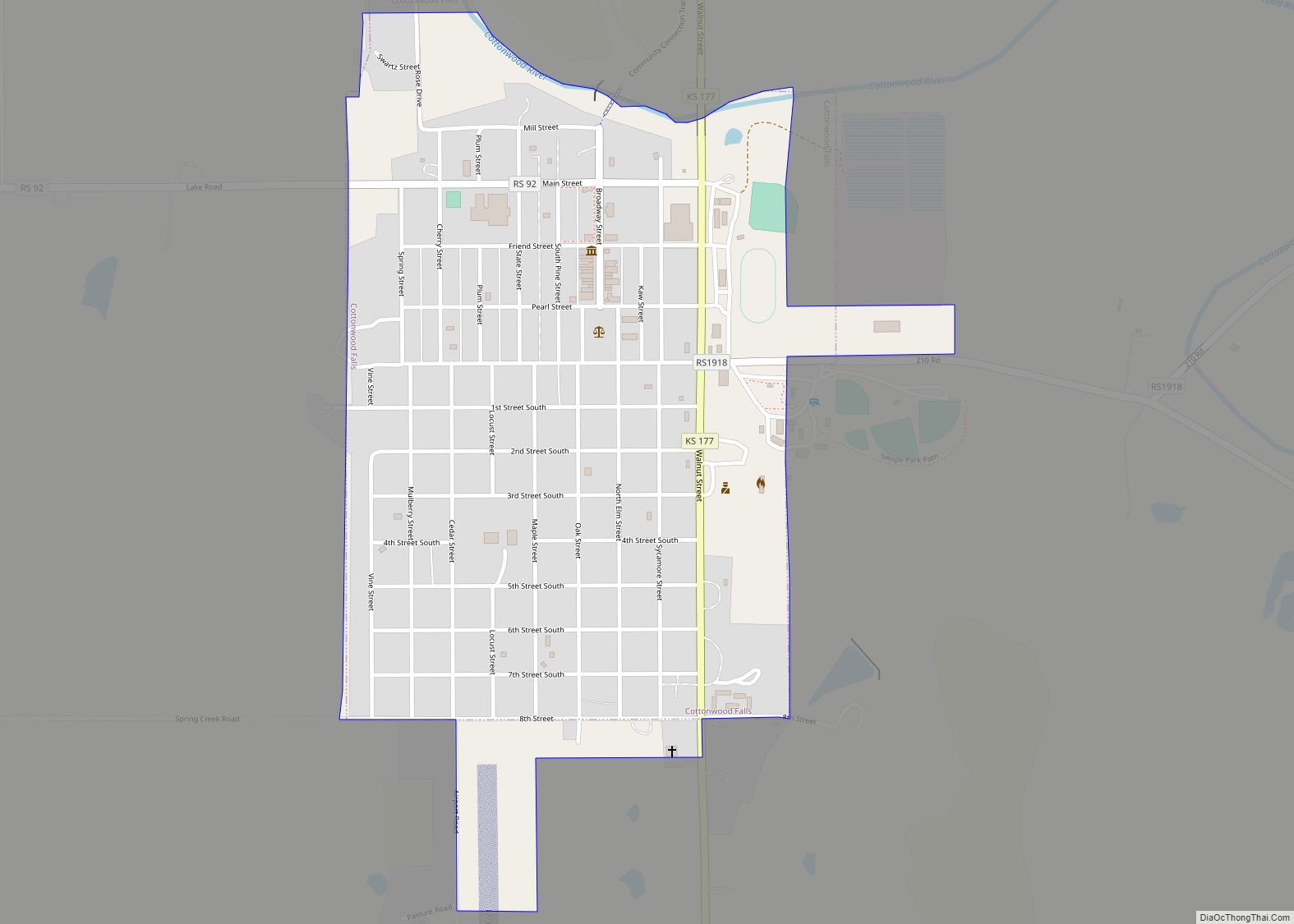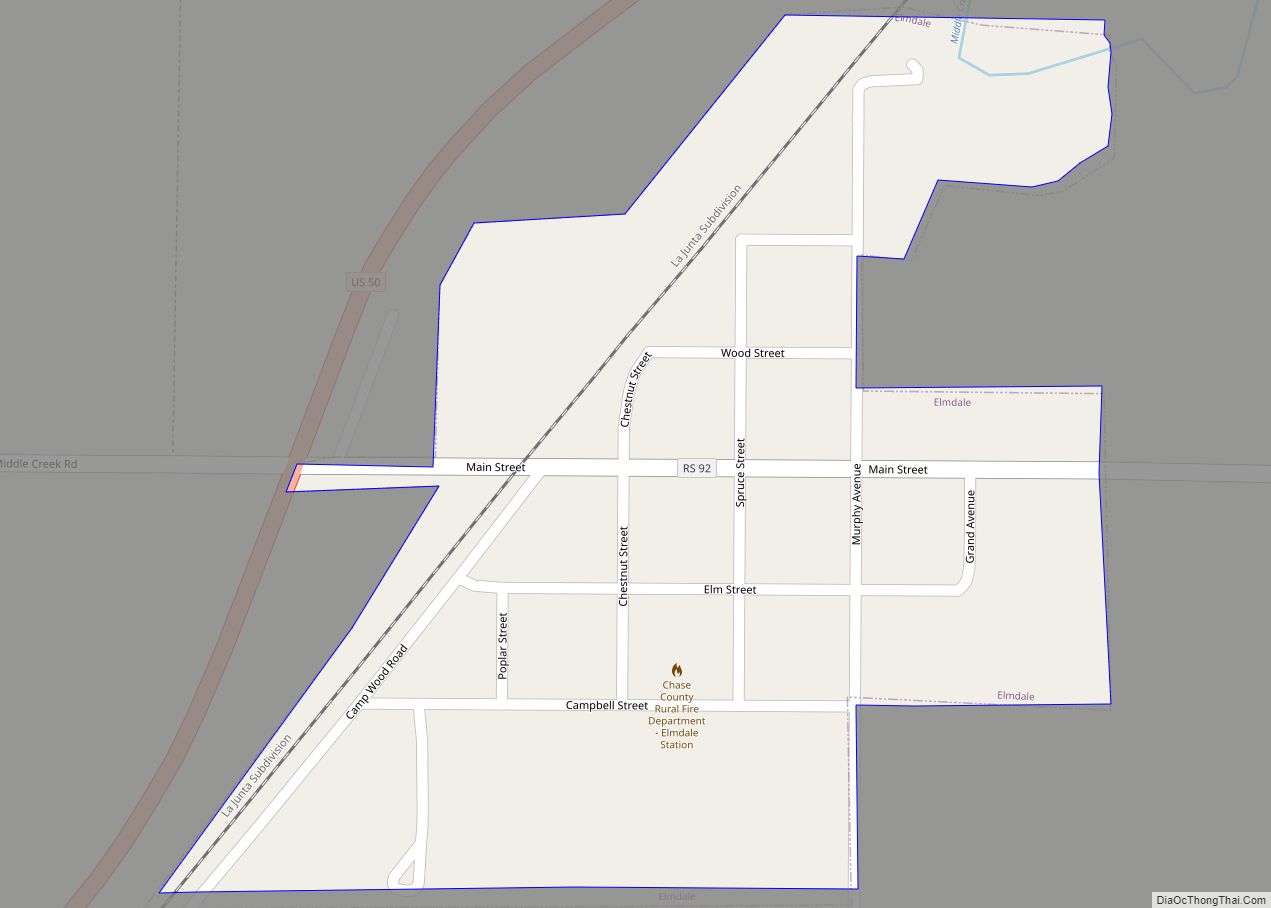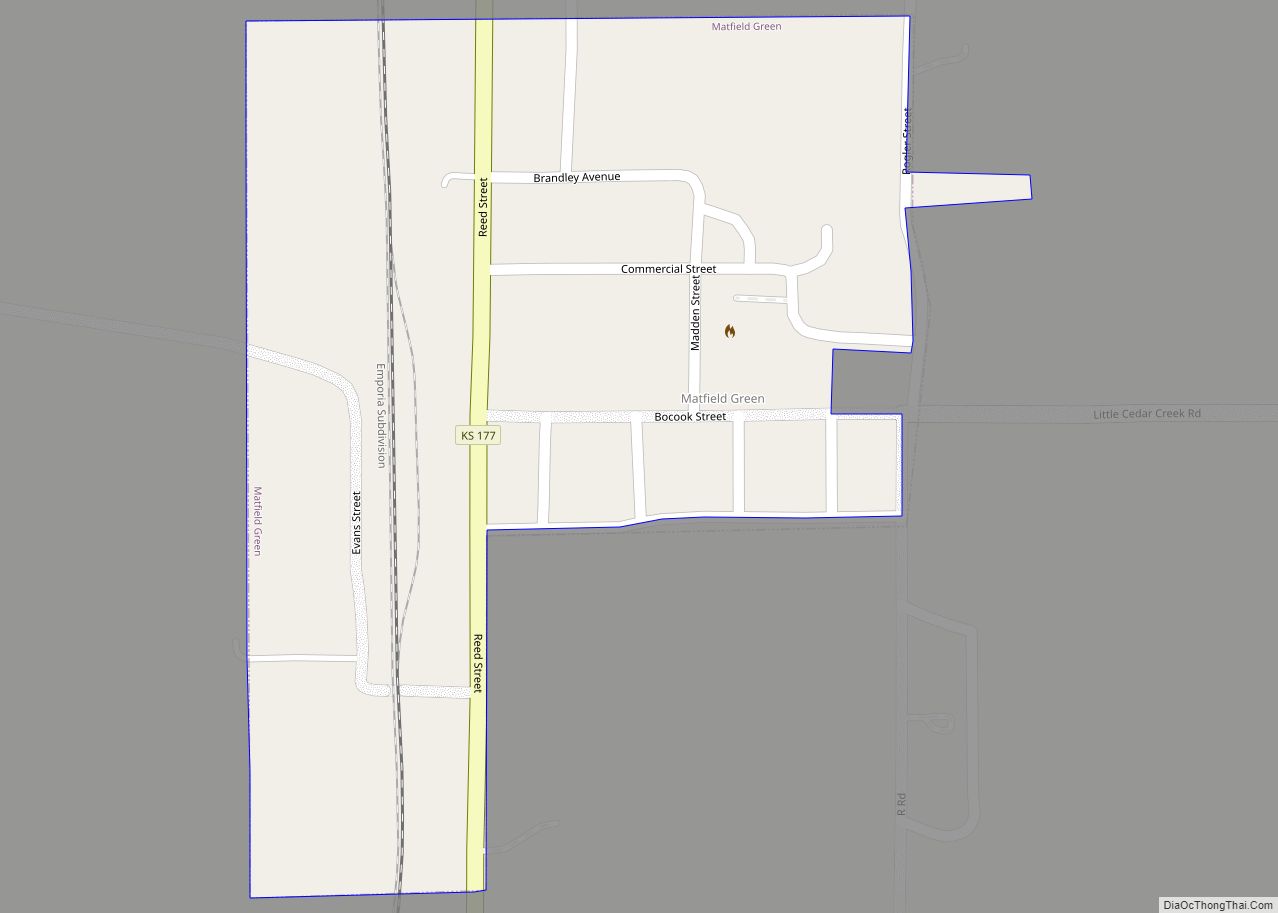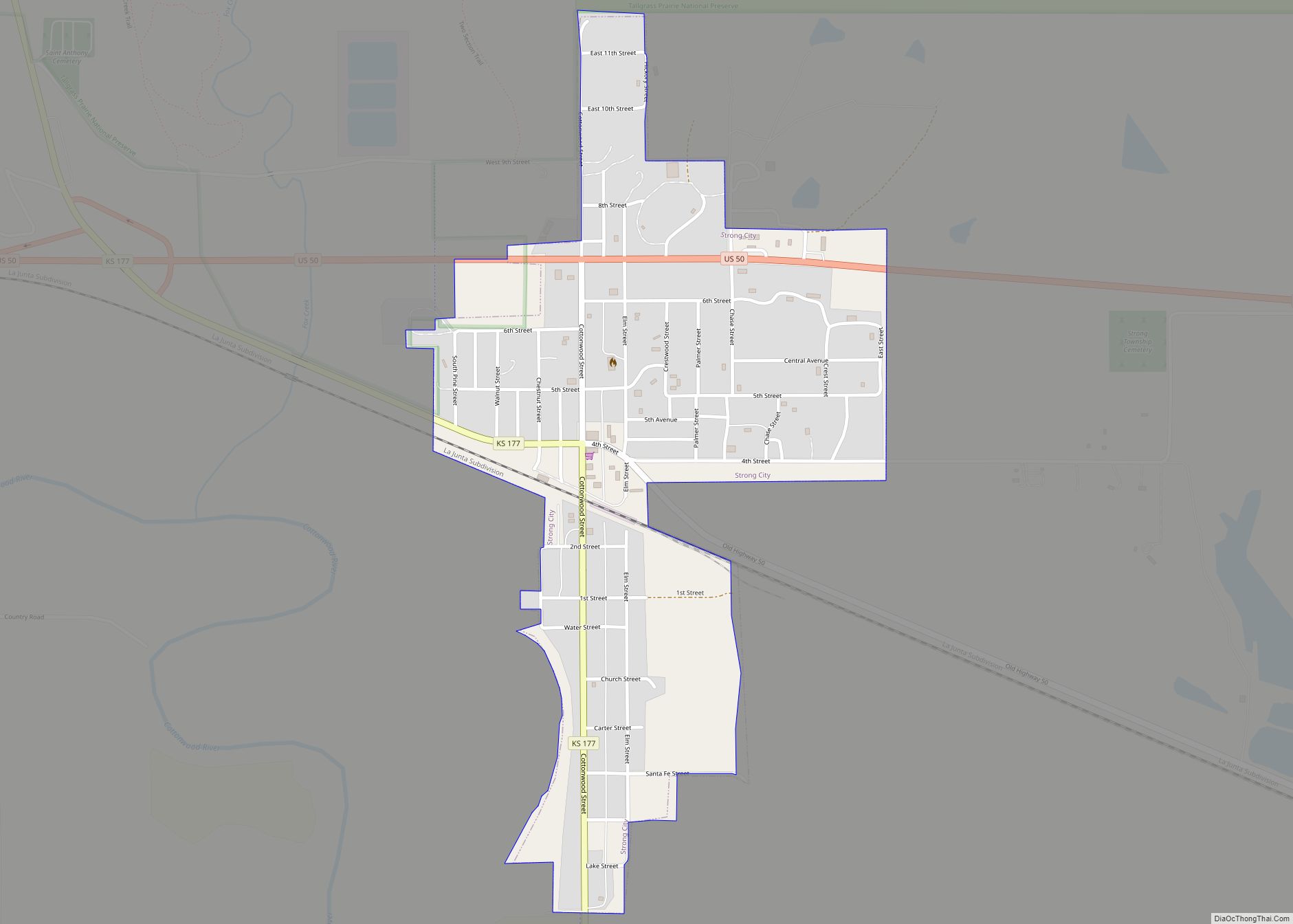Strong City is a city in Chase County, Kansas, United States. Originally known as Cottonwood Station, in 1881 it was renamed Strong City after William Barstow Strong, then vice-president and general manager, and later president of the Atchison, Topeka and Santa Fe Railway. As of the 2020 census, the population of the city was 386. It is located along U.S. Route 50 highway.
| Name: | Strong City city |
|---|---|
| LSAD Code: | 25 |
| LSAD Description: | city (suffix) |
| State: | Kansas |
| County: | Chase County |
| Founded: | 1871 |
| Incorporated: | 1872 |
| Elevation: | 1,194 ft (364 m) |
| Total Area: | 0.55 sq mi (1.43 km²) |
| Land Area: | 0.55 sq mi (1.42 km²) |
| Water Area: | 0.00 sq mi (0.01 km²) |
| Total Population: | 386 |
| Population Density: | 700/sq mi (270/km²) |
| ZIP code: | 66869 |
| Area code: | 620 |
| FIPS code: | 2068650 |
| Website: | strong-city.org |
Online Interactive Map
Click on ![]() to view map in "full screen" mode.
to view map in "full screen" mode.
Strong City location map. Where is Strong City city?
History
Early history
For many millennia, the Great Plains of North America was inhabited by nomadic Native Americans. From the 16th century to 18th century, the Kingdom of France claimed ownership of large parts of North America. In 1762, after the French and Indian War, France secretly ceded New France to Spain, per the Treaty of Fontainebleau.
19th century
In 1802, Spain returned most of the land to France. In 1803, most of the land for modern day Kansas was acquired by the United States from France as part of the 828,000 square mile Louisiana Purchase for 2.83 cents per acre.
In 1854, the Kansas Territory was organized, then in 1861 Kansas became the 34th U.S. state. In 1859, Chase County was established within the Kansas Territory, which included the land for modern day Strong City.
In 1871, the Atchison, Topeka and Santa Fe Railway extended a main line from Emporia to Newton. The city originated in March 1871 when the Atchison, Topeka and Santa Fe Railway was completed to the point then known as Cottonwood Station. Strong City was originally called Cottonwood, and under the latter name laid out in 1872.
In 1881, the name was changed to Strong, in honor of William Barstow Strong, General Superintendent of the Atchison, Topeka and Santa Fe Railway, and afterward the president of the company.
The original depot was a wooden building built in 1872 then burned in 1902 and was replaced in 1903 by another wooden building. From 1887 to 1938, a six stall engine roundhouse employed many workers.
In 1887, Atchison, Topeka and Santa Fe Railway built a branch line from Neva (3 miles west of Strong City) to Superior, Nebraska. This branch line connected Strong City, Neva, Rockland, Diamond Springs, Burdick, Lost Springs, Jacobs, Hope, Navarre, Enterprise, Abilene, Talmage, Manchester, Longford, Oak Hill, Miltonvale, Aurora, Huscher, Concordia, Kackley, Courtland, Webber, Superior. At some point, the line from Neva to Lost Springs was pulled but the right of way has not been abandoned. This branch line was originally called “Strong City and Superior line” but later the name was shortened to the “Strong City line”.
20th century
In 1912, construction of a new depot was begun about 100 feet (30 m) west of the old one, and was finished in 1913. The new brick depot was trimmed in native cut limestone was built for a cost of $20,000. A brick platform some 800-feet long was built along the front of the building, and a 250-foot freight platform was built along the rear of the building. Passenger service was discontinued in the late 1940s.
In 1945, the name was changed again, this time to Strong City.
In 1996, the Atchison, Topeka and Santa Fe Railway merged with Burlington Northern Railroad and renamed to the current BNSF Railway.
21st century
In 2006 and 2015, the “Symphony in the Flint Hills” concert was held two miles north of Strong City with thousands in attendance.
Stone industry
Local stonemasons and builders Barney Lantry & Son contracted with railroad companies for projects throughout the United States. In the beginning it built stone-work for certain phases of railroad construction, but later they did build complete railroads, grading, laying the track, building bridges, stations, roundhouses, and other division buildings.
The first stone-crushers Kansas ever saw were brought to the state by the Lantrys and were operated on a very large scale at Strong City. Most of the stone for masonry and road-ballast for their jobs all over the west, was taken from their quarries at Strong City. Big stones for the Kansas State Capitol came from Strong City, each stone weighing 13,000 pounds. Stone was also used for public and private buildings in Kansas, Missouri, Nebraska, Iowa and Colorado.
When Barney Lantry died in 1895, officials of the Santa Fe Railroad from Los Angeles to Chicago attended his funeral services in Strong City.
Strong City Road Map
Strong City city Satellite Map
Geography
Strong City is located at 38°23′50″N 96°32′13″W / 38.39722°N 96.53694°W / 38.39722; -96.53694 (38.3972360, -96.5369507), in the scenic Flint Hills of the Great Plains. According to the United States Census Bureau, the city has a total area of 0.55 square miles (1.42 km), all of it land. The Cottonwood River is approximately 0.5 miles west of the city, and an old channel of the river is next to the south-west corner of the city.
Climate
The climate in this area is characterized by hot, humid summers and generally mild to cool winters. According to the Köppen Climate Classification system, Strong City has a humid subtropical climate, abbreviated “Cfa” on climate maps.
See also
Map of Kansas State and its subdivision:- Allen
- Anderson
- Atchison
- Barber
- Barton
- Bourbon
- Brown
- Butler
- Chase
- Chautauqua
- Cherokee
- Cheyenne
- Clark
- Clay
- Cloud
- Coffey
- Comanche
- Cowley
- Crawford
- Decatur
- Dickinson
- Doniphan
- Douglas
- Edwards
- Elk
- Ellis
- Ellsworth
- Finney
- Ford
- Franklin
- Geary
- Gove
- Graham
- Grant
- Gray
- Greeley
- Greenwood
- Hamilton
- Harper
- Harvey
- Haskell
- Hodgeman
- Jackson
- Jefferson
- Jewell
- Johnson
- Kearny
- Kingman
- Kiowa
- Labette
- Lane
- Leavenworth
- Lincoln
- Linn
- Logan
- Lyon
- Marion
- Marshall
- McPherson
- Meade
- Miami
- Mitchell
- Montgomery
- Morris
- Morton
- Nemaha
- Neosho
- Ness
- Norton
- Osage
- Osborne
- Ottawa
- Pawnee
- Phillips
- Pottawatomie
- Pratt
- Rawlins
- Reno
- Republic
- Rice
- Riley
- Rooks
- Rush
- Russell
- Saline
- Scott
- Sedgwick
- Seward
- Shawnee
- Sheridan
- Sherman
- Smith
- Stafford
- Stanton
- Stevens
- Sumner
- Thomas
- Trego
- Wabaunsee
- Wallace
- Washington
- Wichita
- Wilson
- Woodson
- Wyandotte
- Alabama
- Alaska
- Arizona
- Arkansas
- California
- Colorado
- Connecticut
- Delaware
- District of Columbia
- Florida
- Georgia
- Hawaii
- Idaho
- Illinois
- Indiana
- Iowa
- Kansas
- Kentucky
- Louisiana
- Maine
- Maryland
- Massachusetts
- Michigan
- Minnesota
- Mississippi
- Missouri
- Montana
- Nebraska
- Nevada
- New Hampshire
- New Jersey
- New Mexico
- New York
- North Carolina
- North Dakota
- Ohio
- Oklahoma
- Oregon
- Pennsylvania
- Rhode Island
- South Carolina
- South Dakota
- Tennessee
- Texas
- Utah
- Vermont
- Virginia
- Washington
- West Virginia
- Wisconsin
- Wyoming
